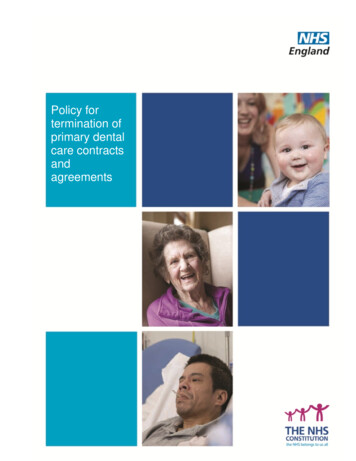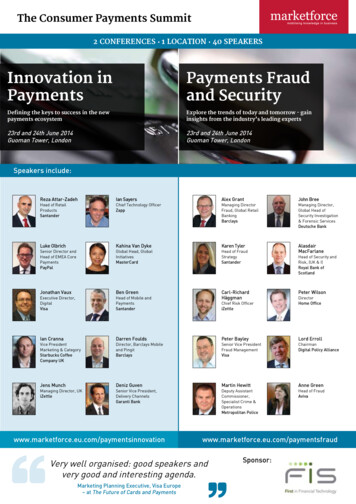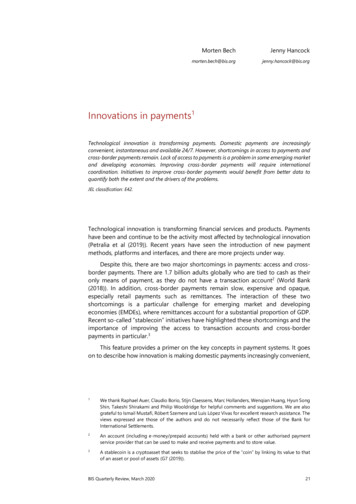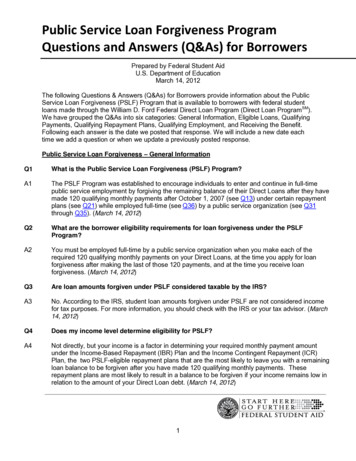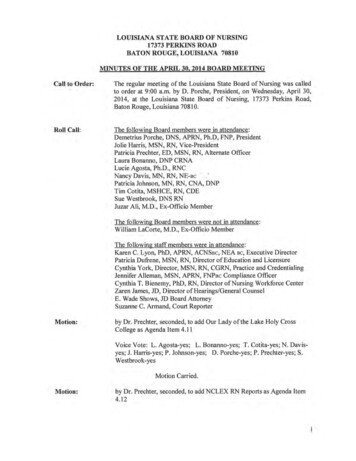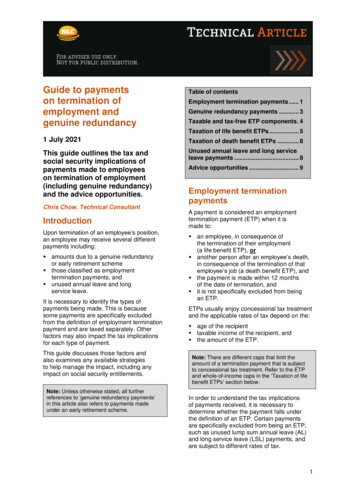
Transcription
Guide to paymentson termination ofemployment andgenuine redundancyTable of contentsEmployment termination payments . 1Genuine redundancy payments . 3Taxable and tax-free ETP components . 4Taxation of life benefit ETPs . 51 July 2021Taxation of death benefit ETPs . 8This guide outlines the tax andsocial security implications ofpayments made to employeeson termination of employment(including genuine redundancy)and the advice opportunities.Unused annual leave and long serviceleave payments . 8Chris Chow, Technical ConsultantIntroductionUpon termination of an employee’s position,an employee may receive several differentpayments including: amounts due to a genuine redundancyor early retirement scheme those classified as employmenttermination payments, and unused annual leave and longservice leave.It is necessary to identify the types ofpayments being made. This is becausesome payments are specifically excludedfrom the definition of employment terminationpayment and are taxed separately. Otherfactors may also impact the tax implicationsfor each type of payment.This guide discusses those factors andalso examines any available strategiesto help manage the impact, including anyimpact on social security entitlements.Note: Unless otherwise stated, all furtherreferences to ‘genuine redundancy payments’in this article also refers to payments madeunder an early retirement scheme.Advice opportunities . 9Employment terminationpaymentsA payment is considered an employmenttermination payment (ETP) when it ismade to: an employee, in consequence ofthe termination of their employment(a life benefit ETP), or another person after an employee’s death,in consequence of the termination of thatemployee’s job (a death benefit ETP), and the payment is made within 12 monthsof the date of termination, and it is not specifically excluded from beingan ETP.ETPs usually enjoy concessional tax treatmentand the applicable rates of tax depend on the: age of the recipient taxable income of the recipient, and the amount of the ETP.Note: There are different caps that limit theamount of a termination payment that is subjectto concessional tax treatment. Refer to the ETPand whole-of-income caps in the ‘Taxation of lifebenefit ETPs’ section below.In order to understand the tax implicationsof payments received, it is necessary todetermine whether the payment falls underthe definition of an ETP. Certain paymentsare specifically excluded from being an ETP,such as unused lump sum annual leave (AL)and long service leave (LSL) payments, andare subject to different rates of tax.1
The following table, though not exhaustive, outlines different payments that may be receivedon termination of employment and distinguishes types of payments that are treated as an ETPfor tax purposes, and those that are not.Table 1: Which payments are ETPs?Payments included in ETPsPayments not included in ETPsUnused sick leave or rostered days offSuper benefitsPayment in lieu of noticeUnused annual leaveGratuity or ‘golden handshake’Unused long service leaveEx gratia paymentsForeign termination paymentsGenuine redundancy payments or earlyretirement scheme payments above thetax-free limitGenuine redundancy payments or earlyretirement scheme payments within thetax-free limitInvalidity payments (for permanent disability,other than compensation for personal injury)Salary, wages, allowances, bonuses andincentives owing to employee for work doneor leave already takenCertain compensation payments fromemployment disputesCompensation for personal injury foreconomic lossCompensation for loss of job orwrongful dismissalAn advance or a loanSeverance payPayments deemed to be a dividendNon-genuine redundancy paymentsEmployee share scheme paymentsPayments for loss of future super paymentsCertain payments for restraint of tradeLump sum payments paid on the death ofan employeeExemptions from 12-month ruleGenerally, an ETP must also be paid within 12 months of termination to be entitled to concessionaltax treatment1. If paid outside this timeframe, it is treated as assessable income and taxed at theindividual’s marginal tax rate (MTR). An exemption2 will apply if the ATO considers that the latepayment is beyond the employee’s control, taking into account the circumstances of each case.Individuals must apply to the ATO requesting it exercise its discretion.Genuine redundancy and early retirement scheme payments, including amounts above thetax-free limit, are exempt from the 12-month rule.Exceptions from the 12-month rule also apply to: payments from a redundancy trust, or payments made by a liquidator, receiver or trustee in bankruptcy of an entity otherwise liableto make the payment, where liquidator, receiver or trustee was appointed within 12 months oftermination date3.1 ITAA97 s82-130(1)(b)2 ITAA97 s82-130(4)3 ATO guidance: ETP 2018/1 and ETP 2019/12
Genuine redundancy paymentsA genuine redundancy payment is a payment received by an employee due to being dismissedbecause their position no longer exists and is not being replaced 4. This usually results in a largertermination package than if the client voluntarily resigned or retired. This additional amount is thegenuine redundancy payment that may be eligible for tax-free treatment.For a payment to be treated as a genuine redundancy payment, the following conditions mustalso be satisfied: the employee is dismissed before the earlier of the following:- the day they reach their Age Pension age5, or- an earlier mandatory age of retirement or before the end of a particular period of service6 for non-arm’s length dismissals – the payment does not exceed amounts reasonably expectedas though it was at arm's length there was no arrangement in place to employ the employee after their retirement, and the payment must not be in lieu of superannuation benefits.Note: ATO Taxation Ruling TR 2009/2 provides a detailed outline of the requirements for a paymentto qualify as a genuine redundancy payment and the interaction between the tax treatment of genuineredundancy payments and other termination payments.Early retirement schemesAn early retirement scheme7 is a scheme undertaken by an employer to change its operations orthe nature of the work force by offering certain classes of employees the opportunity to retire earlyor resign.Early retirement schemes must be approved by the Commissioner of Taxation in writing beforepayments are made. An early retirement scheme payment must also satisfy similar conditionsdescribed above for a genuine redundancy payment to be eligible for tax-free treatment, includingbeing paid within 12 months.Tax-free amount of genuine redundancy paymentsOnce a payment qualifies as a genuine redundancy payment, the calculation of the ‘tax-free amount’determines how much of the ETP is eligible for tax-free treatment.The formula for the tax-free amount for a genuine redundancy payment in 2021/22 is as follows:8Tax-free amount Base amount (Service amount x Each completed year of service)Where: Base amount 11,341Service amount 5,672Each completed year of service Number of full years of completed service(part years of service are not included)Note: Both figures in the formula above are indexed each year in line with movements in AWOTE.4 Termination due to voluntary resignation or retirement, or dismissal for not meeting employment standards do not qualifyas genuine redundancy.5 ITAA97 s83-175, age 65 if dismissal occurred prior to 1 July 2019.6 Any termination payments received upon completion of a fixed term contract will usually not qualify under the tax-free limit.7 ITAA97 s83-1808 ITAA97 s83-1703
If the tax-free amount is greater than or equal to the genuine redundancy payment, the entirepayment is non-assessable and non-exempt income (ie received tax-free by the employee). Wherethe tax-free amount is less than the genuine redundancy payment, the tax-free amount is not taxedbut the amount in excess of the tax-free amount is taxed as an ETP (refer to ‘Table 2: Taxation of lifebenefit termination payments’ for ETP tax rates).Example 1: Tax-free amount less than genuine redundancy paymentTanya is 42 and is being made redundant after a company merger on 15 April 2022, as her roleis no longer required. Tanya has been at the company for over 12 years. As this payment is dueto Tanya being genuinely redundant, she is entitled to the tax-free component. The tax-free amountfor Tanya is 11,341 ( 5,672 12) 79,405. Tanya received 96,000 in redundancy payment,which exceeds the tax-free amount. As such, 79,405 is received tax-free while 16,595 is taxedas an ETP (see Table 2 for ETP tax rates).Example 2: Tax-free amount greater than genuine redundancy paymentIf Tanya only received a redundancy payment of 48,000, the entire amount is tax-free as it isless than the tax-free amount.Age limitationAn employee must be less than their Age Pension age 9 at the time of dismissal for a redundancypayment to qualify as a genuine redundancy payment 10. Where dismissal occurs after AgePension age: the employee is not entitled to a tax-free amount of a genuine redundancy payment the entire payment is taxed as an ETP, and unused AL and LSL payments are subject to less favourable tax rates. Advice tipWhere possible, clients being made redundant who are nearing their Age Pension age may wantto negotiate an earlier dismissal date with their employer to access the concessional tax treatmentfor genuine redundancy payments. However, they should also consider the impacts of negotiatingan earlier termination, such as foregone salary and superannuation guarantee contributions.Taxable and tax-free components of ETPsOnce the amount of the ETP is determined, the ETP usually comprises of taxable component only.Under certain circumstances, a tax-free component may exist where:1. the ETP includes an invalidity segment, or2. part of the ETP employment period occurred before 1 July 1983 (pre-July 83 segment).The calculation of the invalidity segment and/or pre-July 83 segment is determined by formulaswhich are contained in Appendix A – Tax-free component of ETPs. Where a tax-free componentexists, the taxable component of the ETP is calculated as:Taxable component of ETP Total ETP – tax-free component of ETPIn all cases, the tax-free component of an ETP is non-assessable and non-exempt income(ie not included in assessable income for income tax purposes and not subject to tax).9 Or another earlier mandatory retirement age. Age pension age is gradually increasing to 67.10 For terminations that occurred prior to 1 July 2019, employees had to be under age 65 on the date of dismissalfor payments to qualify as a genuine redundancy payment.4
Taxation of life benefit ETPsA life benefit termination payment is a lump sum ETP paid to an employee because of the terminationof their employment (excludes termination due to death of the employee). There are two categories oflife benefit termination payments, ‘excluded’ and ‘non-excluded’ payments, which impacts the amountof an ETP subject to concessional tax treatment. Excluded payments are subject to the ETP cap only,while non-excluded payments are subject to the ETP cap and the whole-of-income cap.The following types of life benefit termination payments are excluded payments:11 genuine redundancy payments above the tax-free amount (regardless of eligibility fortax-free amount) payments for job loss due to invalidity, and compensation payments due to a genuine employment related dispute relating to personalinjury, harassment, discrimination or unfair dismissal.Any other ETP that is not treated as an excluded payment are usually non-excluded payments(eg gratuities or golden handshakes, payments in lieu of notice and severance pay).Table 2: Taxation of life benefit termination payments12Relevant capAge at end of financial yearReached preservation age#ComponentCap amountsTax rate*Tax-freeN/ATax freeTaxableFirst 225,000Up to 17%Above 225,00047%Tax-freeN/ATax freeTaxableFirst 225,000Up to 32%Above 225,00047%Tax-freeN/ATax freeTaxableAbove 180,000(unindexed)47%ETP capUnder preservation age#Whole-of-incomecap Any age* Includes 2% Medicare Levy. Applies to non-excluded payments only, after added to other taxable income.#Preservation age is assessed based on their age on the last day of the financial year.ETP cap amountThe ETP cap13 is the maximum amount of the taxable component of an ETP that a person canreceive and be entitled to concessional tax rates.The rate of tax applicable depends on the ETP recipient’s age on the last day of the financial year.The current ETP cap amount in 2021/22 is 225,00014. However, the ETP cap for a financial yearis reduced by the taxable component of: other ETPs paid earlier in the financial year, and ETPs paid in previous years if relating to the same termination.11 ITAA97 s82-10(6)12 ITAA97 s82-1013 Although the same figure, the ETP cap is separate from the low rate cap, which only applies to certain lump sumsuper benefits. The ETP cap is an annual cap whereas the low rate cap is a lifetime cap.14 Indexed annually to AWOTE, in 5,000 increments if the indexation amount is at least 5,0005
The taxable portion of an ETP is included in assessable income. However, ETPs within the capreceive a tax offset ensuring the rate of income tax paid on the ETP does not exceed the taxrates shown in Table 2. Where a termination payment includes a mixture of excluded and nonexcluded payments, excluded payments are applied against the ETP cap first.This ensures that a person’s ETP cap is not exhausted on the non-excluded payments (whichmay not get concessional tax treatment under the whole-of-income cap rules discussed below)at the expense of excluded payments (which may receive concessional tax treatment).Whole-of-income capIn addition to the ETP cap, the taxable component of non-excluded payments is also subject toa 180,000 whole-of-income cap (non-indexed). This limits the amount of non-excluded ETPsthat are eligible for the ETP tax offset.The whole-of-income cap takes into account other taxable income earned by a client in the financialyear, such as employment income, investment income and lump sum unused AL and LSL payments.The taxable component of a client’s non-excluded ETP being assessed against the whole-of-incomecap is then added last15 to an individual’s other taxable income. If this combined amount is equal toor below the whole-of-income cap, it continues to be eligible for the ETP tax offset.If part or all of the non-excluded ETP added to a client’s other taxable income exceeds the wholeof-income cap in a financial year, the part that is in excess of the cap is taxed at the highest MTR.This part is not eligible for the ETP tax offset, even if there is unused ETP cap remaining.The whole-of-income cap rules do not apply to excluded payments, the tax-free component of anETP or the tax-free amount of a genuine redundancy payment. Advice tipAn employee that finds new employment after termination and earns more taxable income in thesame financial year may pay more tax on the ETP from their previous job when they lodge theirtax return. This is due to the taxable income earned after termination further reducing the amountof whole-of-income cap available for the ETP.Note: refer to Appendix B – Taxable income for whole of income cap for a more comprehensive list ofwhat is included in taxable income for the whole of income cap purposes.Where a client receives multiple ETPs in a financial year, a client’s taxable income also includesthe taxable component of ETPs received earlier in the income year, including amounts that areexcluded payments if subject to the ETP cap (eg ineligible for tax-free amount). This is becausethese payments are included in taxable income and subject to tax, but the ETP tax offset ensuresthe amount of tax paid is limited to the maximum rates of tax applicable in Table 2: Taxation of lifebenefit termination payments.15 Revised explanatory memorandum to Tax Laws Amendment (2012 Measures No. 3) Act 2012 (Cth), paragraph 5.11.6
Example 2: ETP comprising excluded payment onlyVirgil (age 69) has worked for his employer for 5 years. In 2021/22, his company mergeswith another and his position is no longer required. Virgil receives a redundancy and is paid 130,000 (100% taxable component). This amount would not have been received if he hadvoluntarily resigned or retired.Although his payment does not qualify as a genuine redundancy payment as he is overAge Pension age (and not eligible for a tax-free amount), it is still an excluded paymentas it would otherwise have qualified as a genuine redundancy payment.Virgil has not received any ETPs this financial year, therefore his 130,000 redundancypayment is taxed at a maximum of 17% as it is within the 225,000 ETP cap.Example 3: ETP comprising non-excluded payment onlyHenrique (62) retired from his job in April 2022. In the 2021/22 financial year,Henrique received: taxable income from wages and investments of 110,000unused lump sum annual leave of 10,000, andan unused sick leave payment of 105,000 (100% taxable ETP).As the payment relates to an entitlement from voluntary resignation (ie not a genuineredundancy), the unused sick leave is a non-excluded payment and may be subject tothe whole-of-income cap.To work out Henrique’s whole-of-income cap, 180,000 is reduced by Henrique’s othertaxable income and unused annual leave for the financial year, excluding the unused sickleave ETP (ie 180,000 - 120,000). This leaves a whole-of-income cap balance of 60,000,which is less than the non-excluded ETP amount, which is therefore subject to the whole-ofincome cap.Henrique is eligible for the ETP tax offset on 60,000, paying a maximum of 17%tax on this amount, and the remaining 45,000 is taxed at 47% (top MTR includingMedicare levy).Example 4: ETP comprising ‘excluded’ and ‘non-excluded’ paymentsGoing back to the Example 2 with Virgil (age 69), let’s assume the same facts except ontop of the 130,000 excluded genuine redundancy payment, he also receives a 65,000non-excluded termination payment (combined payment of 195,000). He also earned othertaxable income of 165,000 in the financial year.As the ETP comprised excluded and non-excluded payments, the payments are taken to bereceived in the following order: excluded payment of 130,000 is received first, andnon-excluded payment of 65,000 is deemed to be received immediately after.This enables the tax treatment for the separated payments to be determined: The 225,000 ETP cap amount applies to the excluded payment and the entire 130,000of the genuine redundancy portion of the ETP attracts the ETP tax offset (maximum taxrate of 17%)When the 65,000 non-excluded payment is added to his other taxable income of 165,000,this exceeds 180,000 so the amount of ETP tax offset available is limited to the 15,000remaining under the whole-of-income cap. Hence the first 15,000 of the non-excludedpayment attracts the ETP tax offset (maximum tax rate of 17%), while the remaining 50,000 is taxed at 47%.7
Taxation of death benefit ETPsA death benefit termination payment is a lump sum ETP made by an employer to a deceasedemployee’s beneficiaries. It is received by a taxpayer after another person’s death, in consequenceof the termination of the other person’s employment.Death benefit ETPs must be received no later than 12 months after the termination to be eligiblefor concessional ETP tax treatment, though the same exemptions from the 12-month rule detailedon page 2 also apply.Payments to the trustee of a deceased estate are taxed in the estate. The maximum rate of taxdepends on whether the beneficiaries who have benefited, or are expected to benefit, from thepayment are dependants or non-dependants of the deceased.A tax-free component may exist if there is a pre-July 83 segment and is not subject to tax.The taxable component of a death benefit termination payment is subject to the ETP capamount. The table on the following page outlines the rates of tax applicable.Note: Refer to Appendix C for a list of dependants and non-dependants.Table 3: Taxation of death benefit termination payments16RecipientComponentETP cap amount17Tax rate*Tax-freeN/ATax freeFirst 225,000NilBalance over 225,00045%N/ATax freeFirst 225,000Up to 30%Balance over 225,00045%Tax dependantTaxableTax-freeNon-tax dependantTaxable* For payments made directly to individuals, 2% Medicare Levy may also apply for non-zero tax rates. Advice tipDeath benefit termination payments made to a deceased estate and subsequently paidto a beneficiary are not subject to the Medicare levy. This may reduce the tax payable fornon-dependants and for ETPs with taxable components exceeding the ETP cap. Furthermore,payments for unused AL and LSL made on the death of an employee to the deceased’sbeneficiaries or the trustee of the deceased’s estate are exempt from tax18.Unused annual leave and long service leave paymentsLump sum unused AL and LSL entitlements are taxable payments when paid on termination ofemployment but are excluded from being an ETP. Unused AL and LSL payments are subject todifferent rates of tax to ETPs. The payments may still be eligible for concessional tax treatmentdepending on date of accrual and the reason for the employee’s termination. The table belowoutlines the tax rates applicable to lump sum unused AL and LSL payments.16 ITAA97 Subdivision 82-B.17 Applicable for 2020/21 financial year and may be indexed in future financial years.18 ITAA97 s101A(2)8
Table 4: Taxation of lump sum unused AL and LSL payments19Type of leaveUnusedannualleaveUnusedlong serviceleaveType of terminationDate of accrualMaximum tax rate*Voluntary resignationor retirement#Before 18/08/199332%From 18/08/1993Marginal tax rate (MTR)Any32%Before 16/08/19785% of this payment istaxed at MTRFrom 16/08/1978 to17/08/199332%From 18/08/1993MTRBefore 16/08/19785% of this payment istaxed at MTRFrom 16/08/197832%Genuine redundancy,invalidity or earlyretirement Voluntary resignationor retirement#Genuine redundancy,invalidity or earlyretirement * Includes 2% Medicare Levy. Only applies if termination payment satisfies conditions for genuine redundancy, invalidity or early retirement.#These tax rates also apply if genuine redundancy is paid after the individual’s age pension age.The calculation of unused days is determined by the employer as it is necessary to determine: the number of days relating to each period, and adjusting those days for leave taken during that period. Advice tipUnused AL and LSL payments are included in assessable income and may affect entitlementto certain tax offsets and concessions such as: Family Tax Benefit Government co-contribution Low Income Tax Offset, and Senior Australians and Pensioner Tax Offset (SAPTO).An increase in income may also result in a client being liable for the Division 293 tax (additional15% tax on concessional contributions).Advice opportunitiesPersonal deductible and catch-up concessional contributionsThe ability to claim a tax deduction for super contributions may allow many clients to managetax payable in the same financial year as receiving an ETP. Furthermore, the introduction ofcatch-up concessional contributions means that some clients are eligible to contribute any unusedconcessional cap from up to five previous financial years (accrued after 1 July 2018), allowing forgreater management of the tax implications of an ETP. However, eligibility for catch-up contributionincludes the client having a total superannuation balance below 500,000 on the prior 30 June.Note: When recommending clients make super contributions, it’s important to remember that the amountis preserved and a condition of release needs to be met to access the money.19 ITAA97 subdivisions 83-A and 83-B9
Division 293 taxCare should be taken where a client’s taxable income (including the taxable ETP) plus concessionalcontributions20 (CCs) will exceed the 250,000 Division 293 threshold. Although personal deductiblecontributions are not included in taxable income, they are added back under the ‘income forsurcharge purposes’21 used for determining liability to pay Division 293 tax. The portion of nonexcessive CCs that sit above the 250,000 threshold are subject to an additional 15% tax.Where a client’s taxable income (including the taxable portion of an ETP) already exceeds 250,000,all non-excessive personal deductible contributions are subject to the additional 15% tax (ie 30% taxin total). This can have undesired tax implications, particularly where the recipient of the ETP hasreached preservation age. Advice tipGiven that some ETPs may be subject to maximum tax rates of 17% where the recipient hasreached preservation age, this strategy could potentially cause a client to pay more tax in somecircumstances. Clients may also consider making non-concessional contributions if they havesurplus cash to boost the tax-free component of their super, though this would have no impacton their tax liability.Please refer to ‘Guide to concessional contributions’ and ‘Div. 293 tax explained’ availablein the Technical section of MLC AdviserOnline for more information on catch-up CCs and Division293 tax.Defer taking the payment until preservation ageIf a client can delay termination of employment or the payment of a termination payment 22(if employer is happy to oblige) until the financial year that a client will reach preservation age23,there may be tax benefits available.A client receiving a wholly excluded ETP in the financial year they reach preservation age will pay15% less tax on the eligible amounts up to the 225,000 ETP cap than a client below preservationage. Remember, the client’s age is based on their age at the end of the financial year and not thedate the payment is received.Clients receiving an ETP comprising of non-excluded payments may also benefit from the 15% taxsaving on eligible amounts up to the ETP cap upon reaching preservation age, depending on theirlevel of other taxable income (ignoring the ETP) and their remaining whole-of-income cap.Defer taking the payment until the new financial yearIf a client's income is expected to reduce significantly in the next financial year, there may be a benefitin deferring the termination or receipt of payment until after 1 July if the employer is happy to oblige.21Some ETP tax rates are maximum rates, which mean that if a client’s MTR in a financial year is lowerthan the maximum rate, their MTR applies to the payments. Furthermore, the ETP cap is indexed on1 July each year.Where a client has less taxable income in the following financial year, this also means more roomunder the whole-of-income cap. With careful consideration, employees expecting to receive largernon-excluded payments may benefit from this strategy as more of the non-excluded payments maybe eligible for the ETP tax offset.20 Within a client’s relevant CC cap.21 Income for surcharge purposes for Division 293 includes taxable income, reportable fringe benefits, total netinvestment losses and low tax contributions.22 Must be paid within 12 months of termination date to access ETP tax offset unless exemption applies.23 Preservation age is assessed based on their age on the last day of the financial year.10
Centrelink considerationsImpact of termination payments on Centrelink waiting periodsIf a client is considering applying for Centrelink benefits, waiting periods may apply, depending onthe support payment. These may include: an ordinary waiting period income maintenance period, and/or liquid assets waiting period.Clients subject to waiting periods need to ensure they have sufficient funds available to meet ongoingexpenses during that time.Ordinary waiting periodThe ordinary waiting period is seven days and applies to JobSeeker Payment, Parenting Paymentand Youth Allowance (jobseekers). This waiting period commences from the date of claim and isserved in addition to the liquid assets waiting period.Liquid assets waiting periodThe liquid assets waiting period (LAWP) is a period an individual will be ineligible to receiveGovernment income support payments. Liquid assets are readily available assets such as bankaccounts, terms deposits, shares and managed funds. The LAWP is a maximum of 13 weeksand applies to: Jobseeker Payment26 Youth Allowance and Austudy payment.It is measured from the date employment ceased where a person is made redundant. The waitingperiod (up to maximum period of 13 weeks)24 is calculated as follows:Liquid assets waiting period Liquid assets – Maximum reserve amount 500 (single) or 1,000 (couple)The maximum reserve amount is: 5,500 if single with no children, and 11,000 if a member of couple or family (dependent child).The full payment amount from the employer (both tax-free and taxable components) are includedin liquid assets. The LAWP can be served concurrently with the income maintenance period.Extension of maximum liquid assets waiting periodThe Government has proposed25 to extend the maximum LAWP from 13 to 26 weeks.Income maintenance periodThe income maintenance period (IMP) is the period that people who have received terminationor leave payments have these amounts treated as income over an equivalent period.The lump sum payment is generally divided by the number of weeks that the payment representsand is treated as ordinary income and apportioned evenly across the period covered by the IMP.24 If LAWP calculated is less than 13 weeks, rounded down to whole number.25 Social Services Legislation Amendment (Payment Integrity) Bill 201911
There is no maximum period for the IMP. The IMP applies to: JobSeeker Payment26Parenting PaymentYouth AllowanceAustudy Payment, andDisability Support Pension.The gross amount of payments received f
4 If the tax-free amount is greater than or equal to the genuine redundancy payment, the entire payment is non-assessable and non-exempt income (ie received tax-free by the employee). Where the tax-free amount is less than the genuine redundancy payment, the tax-free amount is not taxed but the amount in excess of the tax-free amount is taxed as an ETP (refer to 'Table 2: Taxation of life

